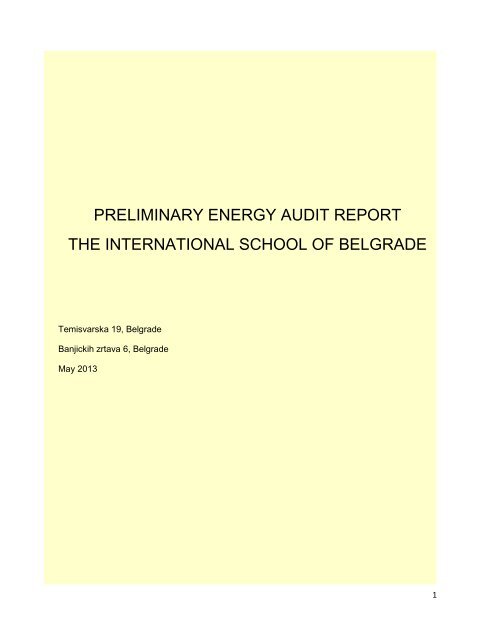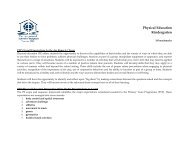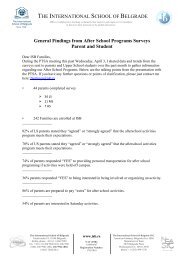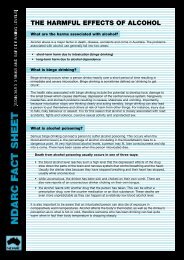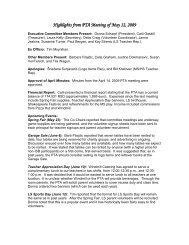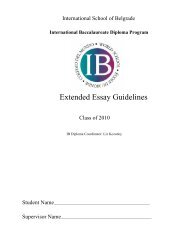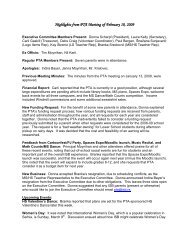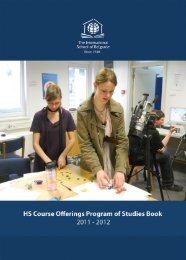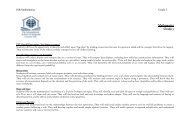Energy Audit Report - the International School of Belgrade
Energy Audit Report - the International School of Belgrade
Energy Audit Report - the International School of Belgrade
- No tags were found...
Create successful ePaper yourself
Turn your PDF publications into a flip-book with our unique Google optimized e-Paper software.
PRELIMINARY ENERGY AUDIT REPORTTHE INTERNATIONAL SCHOOL OF BELGRADETemisvarska 19, <strong>Belgrade</strong>Banjickih zrtava 6, <strong>Belgrade</strong>May 20131
EXECUTIVE SUMMARYAll information in <strong>the</strong> Executive Summary should be drawn from <strong>the</strong> detailedinformation in <strong>the</strong> full report. The Executive Summary should contain a briefdescription <strong>of</strong> <strong>the</strong> preliminary audit including:• Name <strong>of</strong> <strong>the</strong> audited institution, location <strong>of</strong> facility or building audited• Objective <strong>of</strong> audit• Dates <strong>of</strong> preliminary audit• Key systems and equipment studied2
Table <strong>of</strong> Contents• Introduction• Overview <strong>of</strong> current systems in place• Scope <strong>of</strong> work for energy audit• Recommendations and <strong>the</strong> associated costs and savings• Conclusions3
IIntroductionObjectives <strong>of</strong> preliminary auditIssues <strong>of</strong> sustainable development have become one <strong>of</strong> <strong>the</strong> most important globaltopics nowadays, especially in <strong>the</strong> fields <strong>of</strong> energetics and economy. This subject matteris directly related to inability to provide enough energy, and on <strong>the</strong> o<strong>the</strong>r side, topollution and global warming caused by exceeded and irrational consumption <strong>of</strong> energy.Global economy crisis affects all world regions and countries, as well as alleconomic sectors, putting in <strong>the</strong> first plan <strong>the</strong> crucial role <strong>of</strong> sustainability concept andenergy efficiency in <strong>the</strong> long-term strategic planning <strong>of</strong> economic and politicaldevelopment.Struggle with energy resources availability consequently increases price <strong>of</strong>conventional energy resources, making existing, inadequately monitored, energyconsumption inapplicable in <strong>the</strong> future.<strong>Energy</strong> efficiency is defined as efficient use <strong>of</strong> energy in all aspects <strong>of</strong> finalconsumption: industry, transport, services, agriculture and buildings. <strong>Energy</strong> efficiencyis absolutely favourable to simple reduction <strong>of</strong> energy used, since it requires no usagerestraint and it doesn’t compromise basic living and working conditions.Buildings are major specific energy user, demonstrating upward tendency triggeredby both population increase as well as improved standard <strong>of</strong> living. Inside <strong>the</strong> EuropeanUnion buildings consume 41% <strong>of</strong> total energy usage, more than industry with agricultureand services (31%) and transport (28%). On <strong>the</strong> o<strong>the</strong>r hand, this fact also suggests thatbuildings have <strong>the</strong> greatest potential for energy consumption decrease.The main objective <strong>of</strong> this report is to provide a preliminary general insight <strong>of</strong> schoolbuildings’ available resources and possibly locate areas where improvement is possible.Additionally, <strong>the</strong> goal would be to identify major problem areas, to suggest brieflypossible corrective measures, and to provide estimates <strong>of</strong> implementation cost,potential cost savings and investments’ payback periods. In <strong>the</strong> end <strong>of</strong> this auditingphase, a list <strong>of</strong> energy conservation measures should be recommended. With dataobtained from <strong>the</strong> preliminary audit, we expect that decision makers would be able toprioritize energy-efficiency projects, being aware that this level <strong>of</strong> detail is not sufficientfor making a final decision on implementation <strong>of</strong> proposed measures.4
Description <strong>of</strong> facility or building audited – numbers <strong>of</strong> floors, floor area, airconditionedarea, type <strong>of</strong> usage, occupancy, hours <strong>of</strong> operation, age <strong>of</strong> building, etc.LOWER SCHOOLFACILITIES DESCRIPTIONNumber <strong>of</strong> floorsFloor areaAir/C areaType <strong>of</strong> usageOccupancyHours <strong>of</strong> operationAge <strong>of</strong> buildingMain Villa 4 676.62 Entire area Educational 64 9 1932Director's Office 1 187.56 Entire area Educational 49 9 2002Obradovic Hall 1 300.27 Entire area Educational 69 9 1971MPR 1 134.00 Entire area Sports 20 9 2002Friendship Hall 1 235.72 Entire area Educational 40 9 1972<strong>International</strong> Hall 1 340.03 Entire area Educational 70 9 2001MIDDLE SCHOOLNumber <strong>of</strong> floorsFloor areaAir/C areaType <strong>of</strong> usageOccupancyHours <strong>of</strong> operationAge <strong>of</strong> buildingMain building 4 825.79 Entire area Educational 140 9 2011Gym 1 961.99 Entire area Sports 25 14 2011HIGH SCHOOLNumber <strong>of</strong> floorsFloor areaAir/C areaType <strong>of</strong> usageOccupancyHours <strong>of</strong> operationAge <strong>of</strong> buildingMain building 4 946.60 Entire area Educational 100 9 1966Language Lab 1 102.55 Entire area Educational 10 9 1933Math Lab 1 49.08 Entire area Educational 10 9 2004PA Studio 1 157.92 Entire area Educational 10 9 19335
Past years’ energy consumption and cost$25,000.00ISB Electricity Cost 2008-2013$20,000.00$15,000.00$10,000.00Lower <strong>School</strong>Middle <strong>School</strong>High <strong>School</strong>$5,000.00$-2008-2009 2009-2010 2010-2011 2011-2012 2012-2013$12,000.00ISB Water Cost 2008-2013$10,000.00$8,000.00$6,000.00$4,000.00Lower <strong>School</strong>Upper <strong>School</strong>$2,000.00$-2008-2009 2009-2010 2010-2011 2011-2012 2012-20136
$40,000.00ISB Heating Oil Cost 2008-2013$35,000.00$30,000.00$25,000.00$20,000.00$15,000.00Lower <strong>School</strong>Middle <strong>School</strong>High <strong>School</strong>$10,000.00$5,000.00$-2008-2009 2009-2010 2010-2011 2011-2012 2012-2013II Overview <strong>of</strong> Current Systems in Place• Dates <strong>of</strong> preliminary audit• Data collected from manufacturers’ design specifications7
IIIScope <strong>of</strong> Work for Detailed <strong>Energy</strong> <strong>Audit</strong>• Phases <strong>of</strong> work intended• Brief description <strong>of</strong> what will be done at each stage <strong>of</strong> <strong>the</strong> energy audit and whatwill be achieved• Duration <strong>of</strong> each phase• Personnel involved at each phase• Proposed instrumentation plan in detail• A layout <strong>of</strong> <strong>the</strong> proposed location <strong>of</strong> installation <strong>of</strong> instruments and sensors,preferably with picturesThere are generally 4 phases to an <strong>Energy</strong> <strong>Audit</strong>:1. Investigation Phase2. Monitoring Phase3. Analysis & <strong>Report</strong>ing Phase4. Post <strong>Audit</strong> Phase1. Investigation PhaseThis phase involves Facility Manager collecting available relevant data concerning:Reason for <strong>the</strong> <strong>Energy</strong> <strong>Audit</strong>,Level <strong>of</strong> audit required,Date <strong>of</strong> required completion,<strong>Energy</strong> consumption for <strong>the</strong> past 1 to 2 years,Tariffs and related energy supply contracts,Floor areas, staff numbers, production levels,Occupancy hours,Industry energy use/cost benchmark levels,Sub electrical and gas metering equipment,After-hours power usage,Mechanical plant configuration (e.g. air-conditioning plant rated cooling capacity,pump and fan motor kW ratings and efficiency); as-installed drawings, electricalsingle line drawings, and operational & maintenance manuals,Lighting configuration (i.e. lamp number & fitting type, Wattage, ballast type),condition and controls,Compressed air system (if present) including rating, presence <strong>of</strong> air leaks, hours<strong>of</strong> usage,Steam and hot water boilers,Building Management Systems, control strategies and maintenance schedules,Building envelope, shading, orientation, insulation levels,Asset management plan, if any.8
2. Monitoring PhaseThis phase involves obtaining detailed information pertaining to <strong>the</strong> overall site as wellas <strong>the</strong> major energy use categories. The operation <strong>of</strong> key equipment is inspected, andmeasurement <strong>of</strong> a range <strong>of</strong> parameters is undertaken where appropriate, including:Electrical & gas load pr<strong>of</strong>iles,Internal temperature/humidity,Ventilation rate,Light levels,Process specific monitoring.Feedback is also obtained from maintenance staff on issues concerning building andplant operation and maintenance which could well be impacting on energy efficiency aswell as occupant comfort.3. Analysis & <strong>Report</strong>ing PhaseThis phase involves:Determination <strong>of</strong> overall energy efficiency <strong>of</strong> complex; for example kWh/m2 perannum for <strong>of</strong>fice buildings, kWh or $/occupied room night per annum for hotels,kWh or $/item per annum for a manufacturing process,Determination <strong>of</strong> <strong>the</strong> greenhouse emission index,Life cycle cost analysis <strong>of</strong> various energy saving measures,Tariff analysis,Written report on findings.4. Post <strong>Audit</strong> PhaseThis phase involves <strong>the</strong> school acting on <strong>the</strong> <strong>Energy</strong> <strong>Audit</strong> <strong>Report</strong>. We should:Decide if a higher level <strong>of</strong> <strong>Energy</strong> <strong>Audit</strong> is required following a Preliminary <strong>Audit</strong>,Produce an action plan which prioritizes <strong>the</strong> recommended tasks, allocates rolesand contains a timetable for <strong>the</strong>ir completion,Consult with and educate staff about <strong>the</strong> action plan and <strong>the</strong> reasons forimplementing it,Regularly monitor <strong>the</strong> results <strong>of</strong> implemented actions and review <strong>the</strong> plan asrequired9
IVRecommendations and <strong>the</strong> Associated Costs and Savings• Brief description <strong>of</strong> <strong>the</strong> present situation and shortcomings identified• Initial findings, observations and assessment <strong>of</strong> <strong>the</strong> performance <strong>of</strong> systems orequipment• Initial recommendations on energy saving measures with estimated energy andcost savings, investment cost and payback period for each measure. Allnumbers should be supported by information and assumptions made must bestated clearlyVConclusions• Summary <strong>of</strong> recommendations, estimated annual kWh and estimated costsavings, estimated investment cost and payback in table form10


